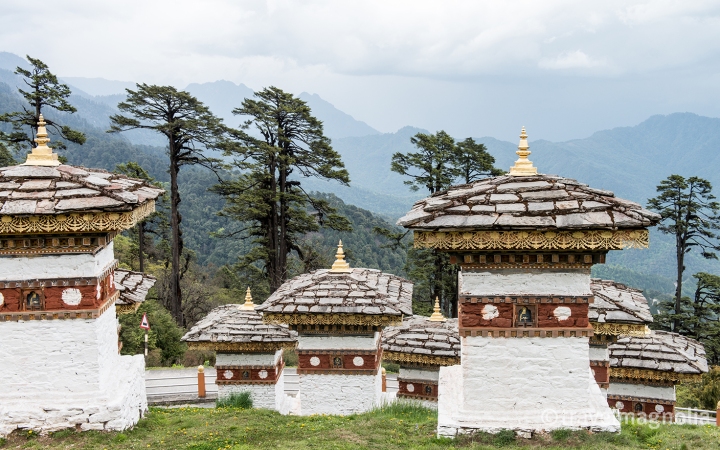 The three-hour drive from Paro to Punakha crosses over Dochula Pass at 3100 meters – site of the Druk Wangyal Chortens. The 108 chortens (stupas) commemorate Bhutanese soldiers who died in the 2003 war against insurgents from India.
The three-hour drive from Paro to Punakha crosses over Dochula Pass at 3100 meters – site of the Druk Wangyal Chortens. The 108 chortens (stupas) commemorate Bhutanese soldiers who died in the 2003 war against insurgents from India. 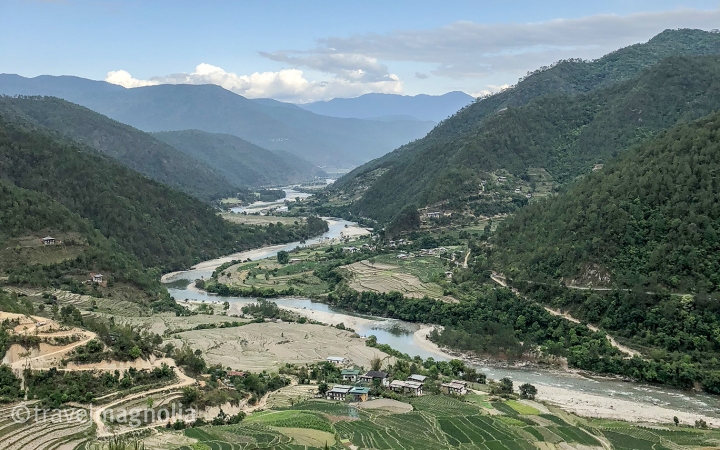 The vast majority of photos I had seen prior to visiting Bhutan were of monasteries and mountains. The incredibly fertile valleys and lush landscapes were a total surprise. Punakha is located at 1200 meters which makes it an ideal first stop for flat landers (those who reside near or at sea level). There are two major rivers: the Mo (mother) and Pho (father) that provide ample water for irrigation.
The vast majority of photos I had seen prior to visiting Bhutan were of monasteries and mountains. The incredibly fertile valleys and lush landscapes were a total surprise. Punakha is located at 1200 meters which makes it an ideal first stop for flat landers (those who reside near or at sea level). There are two major rivers: the Mo (mother) and Pho (father) that provide ample water for irrigation.
 The climate is temperate in winter and fairly hot in the summer. The women wear their hair short to make it easier to farm. Rice is one of the main crops, but we hiked through fields of beans, peppers, corn, eggplant and so many others – a cornucopia of edibles.
The climate is temperate in winter and fairly hot in the summer. The women wear their hair short to make it easier to farm. Rice is one of the main crops, but we hiked through fields of beans, peppers, corn, eggplant and so many others – a cornucopia of edibles.  The exquisite decor on every building amazed us. This farmhouse was quite literally in the middle of nowhere.
The exquisite decor on every building amazed us. This farmhouse was quite literally in the middle of nowhere.  We were lucky to be in Punakha on market day and enjoyed seeing the vast array of produce.
We were lucky to be in Punakha on market day and enjoyed seeing the vast array of produce. Prayer wheels and chortens (stupas) are omnipresent. Here a local woman is making a pilgrimage, circling the stupa in a clockwise direction and turning each prayer wheel on her way.
Prayer wheels and chortens (stupas) are omnipresent. Here a local woman is making a pilgrimage, circling the stupa in a clockwise direction and turning each prayer wheel on her way.

We hiked up to the Khamsum Yuelay Namgyal Chorten [NB photos are not allowed inside these structures but this link gives a vivid description of the treasures within] built in 2004 at the behest of the Queen Mother. Her intent was to bring peace to the world in general and clear obstacles in particular for the people of Bhutan.

Zhabdrung Ngawang Namgyel (1594-1651) known as Blue Beard (easily identified in paintings and statues by that trait) unified Bhutan in the 17th century. Sixteen Dzongs were built as religious, administrative and military fortresses throughout the kingdom. Punakha Dzong is widely considered to be the most beautiful. Certainly, the blooming jacarandas only enhanced this reputation.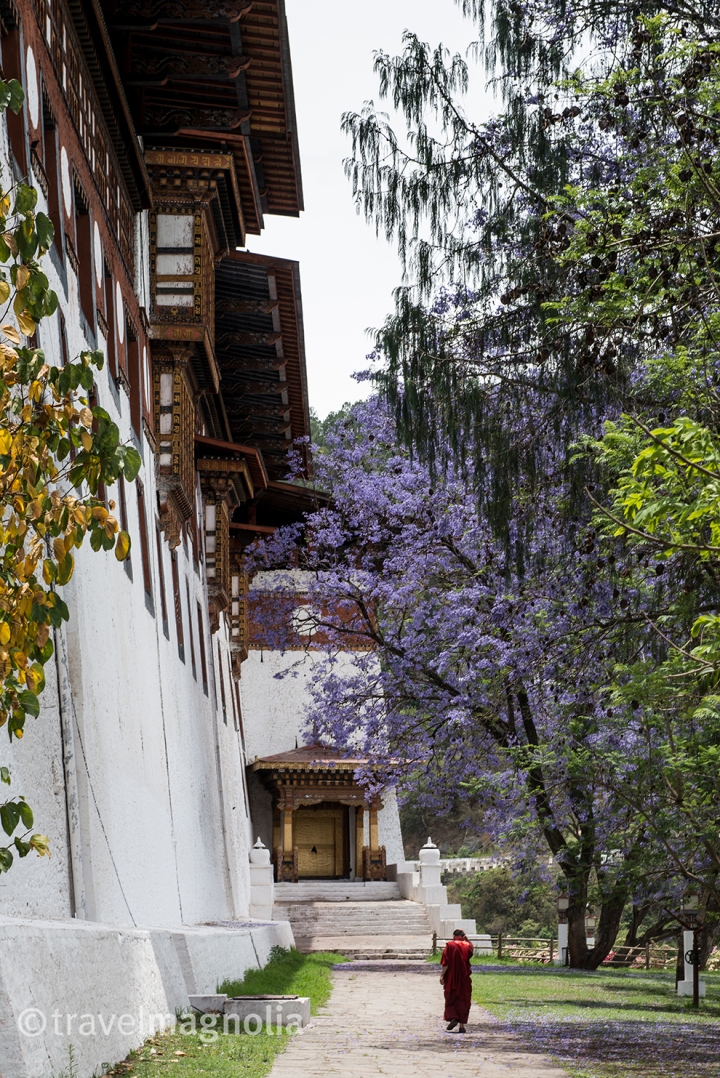 Punakha was the capital of Bhutan until 1955. The chief abbot still spends the winters there because of the milder climate.
Punakha was the capital of Bhutan until 1955. The chief abbot still spends the winters there because of the milder climate. The dzong’s official name is Pungtang Dewa chhenbi Phodrang which translates as The Palace of Great Happiness or Bliss.
The dzong’s official name is Pungtang Dewa chhenbi Phodrang which translates as The Palace of Great Happiness or Bliss.
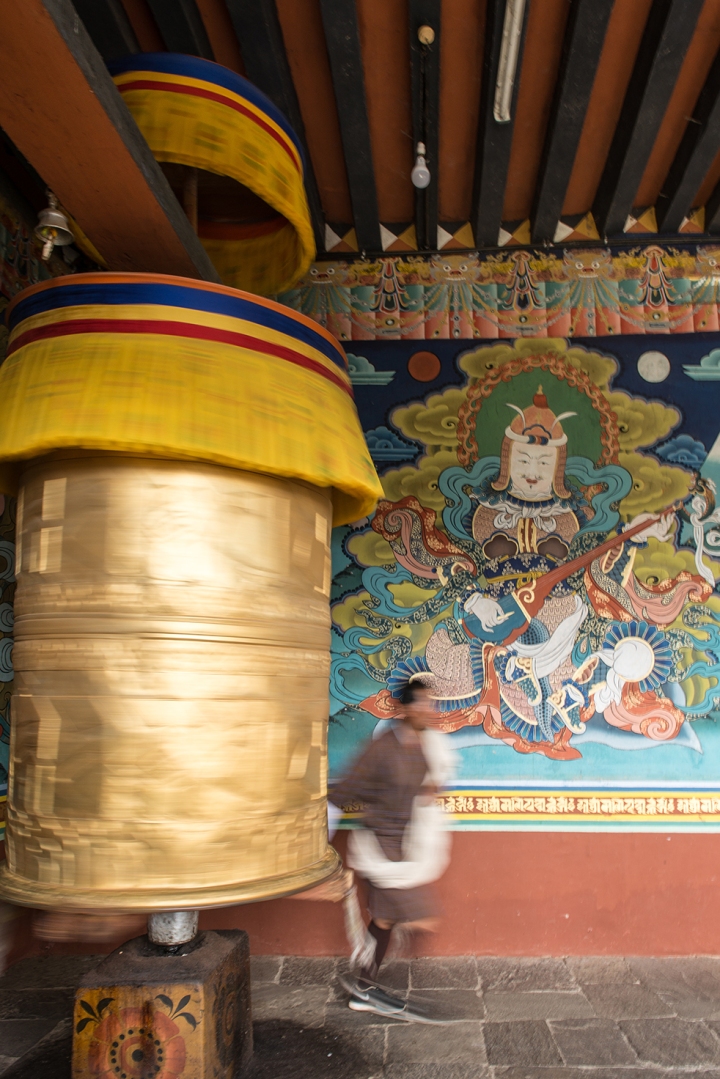
Proper attire is required when visiting Dzongs and Bhutanese men add a white shawl to their Gho (traditional male dress). Colorful paintings cover the exterior and entrance walls and are used as teaching tools in addition to their decorative value. The painting above shows one of the Four Guardian Kings: Dhritarashtra also known as the god of music.

Punakha Dzong contains three courtyards or Dorcheys. The first includes the Utse, or watchtower, which is six stories high. 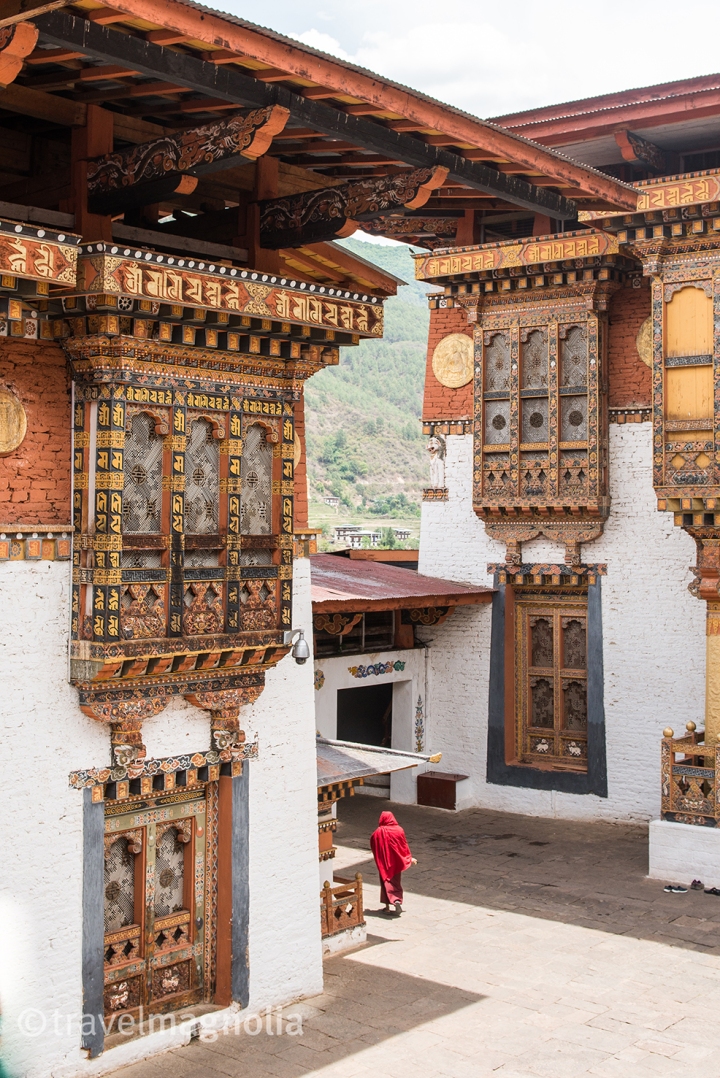
The second courtyard includes the monks’ residences. Note the spectacular carvings and decorations.

The third and final courtyard houses the main temple. The magnificent paintings present important scenes from Buddhist history and are just a hint of the glorious interior. This temple has enormous cultural and historical significance and contains many sacred relics including the remains of Ngawang Namgyal. Many important ceremonies occur here including coronations and royal marriages.
From the everyday to the sublime, I hope you have enjoyed this post on Punakha. Please let me know in the comments section if you would prefer more photos, or more information. I would love to hear from you!


This is great stuff, Maggie. This post covers days 3 & 4 of our upcoming trip, so very relevant. Nice job, and thank you!
LikeLiked by 1 person
Thanks Michael! I envy you the experience and would love to see your itinerary! I will be writing next about the Phobjika Valley and then Bumthang, before finishing with Paro, so stay tuned 🙂
LikeLike
I really enjoyed your beautiful post, Bhutan is a country filled with kindness and beauty of their people. I wish to go there some time. Thank you for sharing
LikeLiked by 1 person
Thank you for stopping by! It is a wonderful country and I hope you get the opportunity to visit one day. In the meantime, stay tuned!
LikeLike
Thank you fro your respond. I am working on a photography trip to Myanmar next year.
LikeLiked by 1 person
Lucky you! I was there five years ago. What time of year are you going?
LikeLike
Thank you Dear. Oh you are so lucky. I am planning on February next year, not sure going with a photography guided group, which seems to be way over my budget or just going on my own.
LikeLiked by 1 person
What a place!!!! I wonder how it’d be to spend a night there…
LikeLiked by 1 person
Hmmm. I hadn’t thought about it. Probably a little spartan…but certainly atmospheric!
LikeLiked by 1 person
Thanks for the mention!
LikeLike
I think you’ve got the balance of pictures and information just right! Gosh, these buildings are incredible… The craftsmanship that’s gone into those carved decorations is just stunning.
LikeLiked by 1 person
Thanks Helen! That’s so nice to hear.
We were blown away by the artisanship throughout the country on every building — from farmhouse to monastery to the airport!
LikeLike
Even the airport?! Now I’m seriously impressed! Bhutan, here I come!
LikeLike
lovely. Would love to visit one day
LikeLiked by 1 person
Thank you for stopping by! I hope you have the opportunity to visit Bhutan – it is absolutely fabulous.
LikeLiked by 1 person
Yes.. it is in my bucket list now:) I wish you a great weekend. cheers:)
LikeLike